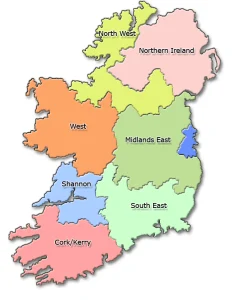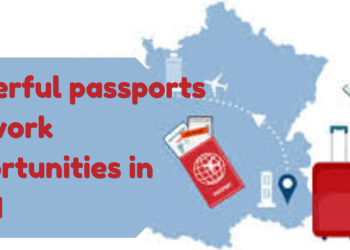Thinking about traveling to the richest country in Europe that is rich in economy as well as history? Indeed, this article will help you get to know more about the three topmost richest countries in Europe.
According to this year’s survey, Ireland has been named the richest country in the world. The GDP of this European country is about 1 lakh 45 thousand 196 US dollars. Apart from Ireland, 2 other countries in Europe have got the title of richest country. They are Luxembourg, Switzerland.
1. Ireland
Ireland is an island nation located in northwestern Europe area . The capital is Dublin of the island of Ireland. Dublin city is quite quiet place despite being a city. As busy as London may seem, Dublin is quite laid-back in comparison. Looks tall on the map. North-South length is only 465 km and side only 285 km, it can be said half of Bangladesh. The largest city is Dublin, with a population of just over six million. This is in fact the third largest island in Europe and the twentieth largest island in the world. Irish people love conversation and have a genuine interest in meeting other people.
Though it is a richest country in Europe, Ireland is a small country with an area of only 70 thousand square kilometers. As being one of the richest countries in Europe, it’s natural beauty is scenic. The water is surging all around. There are numerous hills, several rivers and many lakes. the Atlantic Ocean to the south and west; America only after crossing two and a half thousand kilometers. The Irish are predominantly Catholic Christians. As seen, they are very polite, humble and hospitable. The total population of Ireland is only around 5 million. Ireland’s main sports are soccer and rugby.
Potatoes are the staple food of the Irish. There are above hundred dishes with potatoes in it. Ireland’s soil is not very suitable for farming. It is difficult to grow crops due to the mixture of stones and gravel. In the 1840s, a tragic event took place in Ireland. Some years potatoes and other crops take a severe hit. A kind of disease rots potatoes. Food shortages occur. About 1 million people died in it.
Likewise to Bangladesh, Ireland was a British colony for a long time. The country got independence only in 1921. They have two official languages: English and Irish Gaelic. Moreover, magnificent houses of learning, neo-classical and neo-gothic styles built in the 17th, 18th and 19th centuries such as Castle Ward, Castletown House, Bantry House and other tourist attractions.The three colors of the Irish national flag; Two of these colors represent two religions. Orderly, green is Roman Catholic and orange is Protestant. White color symbolizes unity. Climate is temperate, mild winters, cool summers, regular humidity, half the time cloudy.
The number of Muslims in Ireland is increasing, so are mosques. There are currently about 50,000 Muslims living in Ireland which is 1 percent of the total population. Clearly, the number of Muslims is expected to reach one lakh in 2020. Every town in Ireland has mosques. In addition, Muslim girls there can wear hijab to school. There is a huge demand for Islamic clothing in Ireland. Many Muslim countries import Islamic clothing to Ireland.
Ireland’s higher education system offers a wide range of options and spans the university sector, the technical sector, private colleges for education and independent colleges. Institutions that fall into the first three groups are autonomous and self-regulating, but are actually funded by the state. Countless students especially from Bangladesh travel to Ireland every year. The estimated cost of completing a Bachelor’s degree in Ireland is between €10,500 and €15,150. The estimated cost of completing a master’s degree ranges from 7,400 euros to 15,720 euros. Even so, it is yet to be a popular destination for the Asian students.
Dublin for literature is quite liberal regardless of all. The literary events there are like Shuridhana. A perfect blend of literature and music to enjoy whereas, you can enter the ‘Dublin Literary Pub Crawl’. Literature through sheer joy. Famous Irish novelists and poets like James Joyce used to come to this city of Dublin for these.
2. Luxembourg
Luxembourg is not only the richest country in Europe, it is considered richest in the world. Though a small country, it is a prosperous country with a strong economy and high standard of living. The main sectors of the Luxembourg economy include banking, financial services, manufacturing and tourism. The country has a strong financial sector that hosts many of the world’s largest banks. Luxembourg also has a high-tech industry specializing in sectors such as electronics, chemicals and pharmaceuticals.
Luxembourg has a high standard of living. The country has a strong healthcare system, an education system and a safe and healthy environment. Luxembourg has a healthy economy and high standard of living, making it the richest country in the world.
Some specific reasons why Luxembourg is rich are:
A strong financial sector: Luxembourg has a strong financial sector that hosts many of the world’s largest banks. Because of these banks, there is a large flow of investment and business opportunities in Luxembourg.
A high-tech industry: Luxembourg also has a high-tech industry that specializes in sectors such as electronics, chemicals and pharmaceuticals. These industries make a significant contribution to Luxembourg’s economy.
A safe and healthy environment: Luxembourg has a safe and healthy environment. It improves quality of life and attracts workers and businesses.
Apparently, Luxembourg becomes wealthy due to it’s strong economy and high standard of living. In fact, the country relies on a strong financial sector, a high-tech industry and a safe and healthy environment.
3.Switzerland
Switzerland is a country located in Europe. Despite being a richest country in Europe, it is not a member of the European Union. Its currency is the Swiss franc and its annual gross domestic product is 512.1 billion Swiss francs (2007 AD). It is one of the richest countries in the world.
In 2006, the population was around one quarter crore. The per capita annual income of people in this country is 67,823 Swiss Francs (2007 AD). The city of Bern is the capital of Switzerland. Two other famous cities are Zurich and Geneva.
People on the Zurich side speak German and people on the Geneva side speak French. The Alps and vast lakes endow Switzerland with other natural beauty. Obviously, It is a very attractive country for world tourists. Switzerland’s clocks, trains and chocolates are world famous. However, Swiss banks are notorious for keeping black money safe. The country has no regular army though.
History:
Since 1848 the Swiss Confederation has been a federal republic of autonomous cantons, some of these confederations are over 700 years old. Therefore, it is one of the world’s oldest confederations still in existence.
The early history of the region is related to the Alpine culture. The Helvetti race lived in Switzerland. The country came under Roman rule in the first millennium BC. In the late classical period, Gallo culture was influenced by Germanic influence and the eastern part of Switzerland became part of the Alemannic lands. In the 6th century, Frankish Empire had annexed the area of Switzerland. During the Middle Ages the eastern part became part of the Duchy of Swabia of the Holy Roman Empire and the western part of Burgundy.
Prehistory:
Archeological evidence suggests that hunter-gatherers inhabited the lowlands north of the Alps during the Middle Palaeolithic, 150,000 years ago. The area became populated during the Neolithic period. Remains of Bronze Age pile dwellers from around 3800 BC are found in many lake areas. Around 1500 BC Celtic tribes lived in this area. The Rhaetian race lived in the eastern region and the Helvetti race in the western region.
Middle Ages:
AT earlier times, feudalism flourished in Switzerland under the Carolingian kings during the Middle Ages, and monarchies and bishoprics governed the system. Following that, in 843, the Treaty of Verdun was signed between Burgundy and Lotharingia and between Alemannia and the Eastern Kingdom of Louis the German. Nonetheless, carolingian influence declined in the 10th century, and the Magyars destroyed Basel in 917 and St. Gallen in 926.
Industrialization and Modern Switzerland: As a result of the civil war, Switzerland adopted a federal constitution in 1848. Later, it was extensively revised in 1874. Thereafter, it transferred responsibility for defense, commerce and law to the federal government and to the cantonal government in all other matters. Since then, Swiss history has seen consistent political, economic and social growth throughout most of the 20th century.
Although, Switzerland was originally a rural area, the Industrial Revolution reached its peak in the cities in the late 19th century, especially in the textile industry. For example, textiles, including silk, were one of the main industries in Basel. In 1888 women constituted 44 percent of wage earners. About half of the women worked in textile mills.
On the other hand, housemaid was the second highest branch of work. Between 1890 and 1910, the number of female workers was higher than in the late 1960s to 1970s.
Politics:
The political situation of the country is very stable. One of the hallmarks of the Swiss government is that its president changes every year on January 1st. Each minister of the Council of Ministers, constituted for a six-year term, serves as the President for one year in turn.
Administrative Regions: Switzerland has a total of 26 cantons. At the time of the historical confederation, each of these independent states had separate borders and systems of government. Currently, all of them belong to Switzerland.
Geography:
Switzerland is located in the central part of Western Europe. It shares border with some other richest countries in Europe. There are Germany to the north, Austria and Liechtenstein to the east, Italy to the south and France to the west. Switzerland is a small mountainous country. It consists of the central Alps and the northern pre-Alps mountains. Here there is a diverse collection of mountains, hills, rivers and lakes. The country has an area of 41,285 square kilometers and is 220 km north-south and 350 km long east-west. The southern shores of Lake Maggiore are lined with pine forests only 192 meters above sea level. On the other hand, only 100 km away from there, there are 48 snow-capped mountain peaks with a height of more than 4000 meters. Switzerland can be divided into three main geographical regions, the Jura, the Swiss Plateau and the Alps.
Last but not the least, all three countries are among the top richest country in Europe. In fact, if you plan your next tour to a place in Europe, consider them in your list. You will not regret the experience I believe.






















